Speakers Share the Latest on Food Safety and Quality at IFT’s 2014 Annual Meeting
FOOD SAFETY & QUALITY PREVIEW
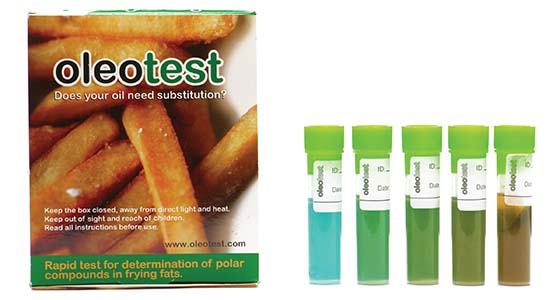
The Scientific Program at the IFT Annual Meeting & Food Expo in New Orleans, La., June 21–24, 2014, will feature many presentations of value to food professionals. The following are brief descriptions of symposia related to food safety and quality.
Food Safety
In session 015, “The Safety of Spices: Challenges and Opportunities,” on Sunday, June 22, from 10:30 a.m. to 12 p.m., Hassan Gourama of Pennsylvania State University will discuss strategies needed to minimize the risk of molds and mycotoxins in spices; Purnendu Vasavada of the University of Wisconsin, River Falls, will discuss pathogenic contamination of spices, how the spice industry is addressing the problem, and the suitability of novel technologies for decontamination of spices; R. Lawrence of McCormick & Co. Inc. will discuss the benefits that spices bring to the food supply and associated food safety risks; and G. Ziobro of the U.S. Food and Drug Administration (FDA) will discuss the FDA Food Safety Modernization Act (FSMA) and FDA programs to ensure safety of spices.
In session 033, “Microwave Food Safety and Validation Criteria for Refrigerated and Frozen Foods,” on Sunday, June 22, from 1:30 p.m. to 3 p.m., Raghu Ramaswamy of Heinz North America will discuss why consumer understanding of frozen food storage, microwave oven usage, and safe food consumption needs to be addressed scientifically; Rishi Banerjee of the American Frozen Food Institute will describe the “Cook It Safe” campaign, which is designed to raise awareness among consumers about the need to fully cook prepared foods to prevent foodborne illness; and Jeyamkondan Subbiah of the University of Nebraska-Lincoln will describe a virtual microwave test kitchen concept to help food product developers design high-quality products for use in a wide range of domestic microwave ovens.
In session 041, “The Role of Lactic Acid Bacteria in Foodborne Human Pathogens Intervention: Mechanisms and Applications for Food Safety,” on Sunday, June 22, from 1:30 p.m. to 3 p.m., J.M. Sturino of Texas A&M University will describe how lactic acid bacteria (LAB) can be used to enhance the safety of fresh produce, and Matthew Taylor of Texas A&M University will discuss antimicrobial technologies based on LAB and regulatory oversight.
In session 098, “USDA/NIFA National Integrated Food Safety Initiative Competitive Grants Program: Improving the Safety of Fresh and Fresh-Cut Fruits and Vegetables,” on Monday, June 23, from 10:30 a.m. to 12 p.m., Jodi Williams of the National Institute of Food and Agriculture (NIFA) will describe the U.S. Dept. of Agriculture (USDA)/NIFA competitive grants program, Elizabeth A. Bihn of Cornell University will describe development of decision trees to help fruit and vegetable growers develop good agricultural practices, Elliot T. Ryser of Michigan State University will describe an integrated approach to enhance the microbial safety of fresh-cut fruit and vegetable products, and Junehee Kwon of Kansas State University will discuss development of a produce safety training program for school foodservice systems.
In session 157, “Viruses: Challenges and Opportunities for Detecting and Controlling Human Enteric Viruses in Fresh Produce,” on Monday, June 23, from 1:30 p.m. to 3 p.m., J.L. Cannon of the University of Georgia will discuss methods for recovering and detecting foodborne viruses from produce and molecular-based technologies for distinguishing between infectious and non-infectious viruses; Stephen Grove of the Institute for Food Safety and Health will discuss human enteric viruses and factors associated with viral contamination of fruits and vegetables; and Troy Smith of Radiant UV solutions will explain how ultraviolet light can provide in-process control of bacterial, fungal, and viral contamination.
In session 220, “Development of Analytical Tools for Rapid Detection of Chemical Hazards in Foods,” on Tuesday, June 24, from 10:30 a.m. to 12 p.m., Lili He of the University of Massachusetts will discuss how surface-enhanced Raman spectroscopy (SERS), a combination of Raman spectroscopy and nanostructures such as silver dendrites, can detect multiple pesticides on apple surfaces and in apple juice, and Kelly Dorweiler of General Mills will discuss how atmospheric-pressure gas chromatography coupled with high-resolution quadrupole time-of-flight mass spectrometry can be used for analysis of pesticides in food matrices.
--- PAGE BREAK ---
Regulatory
In session 004, “Food Clinical Trials and IND Applications—The New Hybrid?” on Sunday, June 22, from 7:15 a.m. to 8:15 a.m., K. Musa-Veloso of Intertek Cantox will discuss the FDA guidance document that specifies that certain clinical studies for foods and dietary supplements may require the submission of an investigational new drug application; Anthony Pavel of Morgan, Lewis & Bockius LLP will discuss the legal and regulatory obligations that the guidance will impose on the food industry; and David Cockram of Abbott Nutrition will address the impacts the guidance is having on infant formula and medical foods research and development.
In session 005, “GRAS: Another Generation for Safety Assessment?” on Sunday, June 22, from 7:15 a.m. to 8:15 a.m., A. Hayes of Harvard University will discuss what manufacturers of foods and ingredients need to know to determine that the use of an additive is generally recognized as safe (GRAS) and the need for updating the approach; D. Keefe of the FDA will discuss how the agency’s procedures regarding exemption of GRAS substances from premarket approval have evolved since 1958; Thomas G. Neltner of the Natural Resources Defense Council will discuss questions about conflicts of interest in GRAS safety determinations; Diane B. McColl of Hyman, Phelps & McNamara will discuss regulatory and enforcement implications of the Pew Charitable Trusts recommendations regarding potential conflicts of interest in GRAS determinations; Claire Kruger of Spherix Consulting Inc. will discuss how regulatory and scientific thinking are incorporated into GRAS determinations; and Roger A. Clemens of the University of Southern California will discuss how the current process involving experts with appropriate experience and training has demonstrated the assurance of safe food ingredients.
In session 080, “Anticipating FDA-Proposed Changes to Nutrition Facts Labels: Implications for Foods Marketed in the U.S.,” on Monday, June 23, from 8:30 a.m. to 10 a.m., E. Campbell of EAS Consulting Group LLC will discuss the FDA’s proposed changes to the nutrition labeling requirements; V.L. Fulgoni of Nutrition Impact will discuss how results of the What We Eat in America and National Health and Nutrition Examination Survey can be used in addressing proposed changes to the nutrition facts panel; and R.C. Post of FoodMinds LLC will discuss why food manufacturers, retailers, and nutrition educators will need to help educate customers about the differences between current and future food labels.
In session 083, “The Buzz on Caffeine: New Developments in the Safety and Regulation of Foods and Dietary Supplements,” on Monday, June 23, from 8:30 a.m. to 10 a.m., James R. Coughlin of Coughlin & Associates will discuss concerns about the safety of caffeine, results of the Institute of Medicine’s August 2013 scientific workshop, the FDA’s reaction to the institute’s findings, and the expected FDA guidance on caffeine in foods and beverages; Rick Kingston of SafetyCall International will discuss the need to determine the accuracy of adverse event reports regarding caffeinated beverages; R.H. Adamson of TPN Associates LLC will discuss the safety of caffeine and other ingredients in energy drinks and possible interactions; and James C. Griffiths of the Council for Responsible Nutrition (CRN) will discuss the safety of caffeine and the CRN’s recommended industry guidelines regarding its use in dietary supplements.
In session 095, “Food Imports and the Food Safety Modernization Act: Update on the FDA’s Implementation of the Foreign Supplier Verification Program Requirements,” on Monday, June 23, from 10:30 a.m. to 12 p.m., Luis A. Mejia of the University of Illinois will discuss how compliance with the FDA’s proposed foreign supplier verification program may require some businesses to reorganize or acquire additional human resources; Ricardo Carvajal of Hyman, Phelps & McNamara PC will discuss the regulatory implications of the FSMA for ingredient suppliers, importers, finished-product manufacturers, and distributors; and Rebeca López-García of LOGRE International Food Consulting will discuss the impact, challenges, and issues faced by Mexican suppliers.
In session 151, “FSMA as Seen Through the Eyes of Three CFSAN Directors,” on Monday, June 23, from 1:30 p.m. to 3 p.m., three past directors of the FDA’s Center for Food Safety and Applied Nutrition —M. Landa of the FDA, Joseph A. Levitt of Hogan Lovells LLP, and S. Sundlof of EAS Consulting Group LLC—will discuss the FSMA.
In session 191, “Legal and Regulatory Challenges for Ingredient Suppliers to Global Food Companies,” on Tuesday, June 24, from 8:30 a.m. to 10 a.m., Brian Schaneberg of Starbucks Co. will discuss how companies must demand more information from their ingredient suppliers to meet import needs across the globe; Anthony Pavel of Morgan, Lewis & Bockius LLP will discuss the challenges small- and medium-sized ingredient suppliers face; and Josh Kim of Cargill Inc. will address the opportunities and challenges facing a large ingredient supplier in both sourcing raw materials and providing ingredients to downstream customers in the food chain.
--- PAGE BREAK ---
In session 257, “Regulating Sugar: Existing Policies, Trends, and Scientific Research,” on Tuesday, June 24, from 8:30 a.m. to 10 a.m., John S. White of White Technical Research will provide background information on the history, composition, functionality, and availability of sugars and why they are so widely used in foods and beverages today; P. Courtney Gaine of the International Life Sciences Institute will discuss sugar metabolism, current intakes, dietary guidance, and the relationship between sugar intake and health; and Roger A. Clemens of the University of Southern California will discuss dietary guidelines and public policy and how conflicting evidence regarding the relationship between sugar consumption and obesity/overweight confuses consumers.
In session 216, “Food Ingredients for Pets: Regulatory Hurdles,” on Tuesday, June 24, from 10:30 a.m. to 12 p.m., George Collings of Collings Nutrition Solutions will discuss ingredients approved and not approved for use in pet food products and the regulatory hurdles in place; William J. Burkholder of the FDA’s Center for Veterinary Medicine will discuss how determining the safety of substances for use in animal foods differs from determining safety in human foods; and Karine Derouet of Regulations Nutrition International will compare how pet foods are regulated by the United States, European Union, and other countries.
In session 221, “Adverse Events: When Unexpected Dietary Supplement Toxicity Sets Off an Alarm,” on Tuesday, June 24, from 10:30 a.m. to 12 p.m., James C. Griffiths of the Council for Responsible Nutrition will discuss challenges regarding adverse event reports (AERs) pertaining to dietary supplements and ingredients that can lead to inappropriate or premature conclusions of their safety; Scott A. Jordan of Health Canada will discuss methods for increasing the quantity and quality of information to enhance regulatory decision making for dietary supplements; Rick Kingston of the University of Minnesota will discuss approaches to monitoring the safety of dietary supplements and specialty foods such as caffeinated beverages and the potential limitations in current approaches to AERs; H. Oketch of the U.S. Pharmacopeia (USP) will describe the USP’s safety evaluation of the dietary supplement Salvia miltiorrhiza (Chinese Salvia); and Mary Hardy of the University of California, Los Angeles, will discuss how an appropriate response to an AER should utilize input from consumers, clinicians, manufacturers, and regulators.
In session 237, “The Clean Label Approach in Product Development of Further Processed Meats,” on Tuesday, June 24, from 1:15 p.m. to 2:45 p.m., Kathleen Glass of the University of Wisconsin, Madison, will discuss applications and limitations of natural substitutes for chemical preservatives with known activity against pathogens, Amanda Gipe McKeith of Western Kentucky University will discuss natural cures and antimicrobials that can be used to maintain a clean label on meat products, and Jeff Canavan of the USDA’s Food Safety and Inspection Service will discuss clean labeling of processed meats.
Sensory
In session 002, “Bridging Sensory Fundamentals and Real World Application,” on Sunday, June 22, from 7:15 a.m. to 8:15 a.m., Sarah Kirkmeyer of Givaudan Flavors Corp. will discuss how the fundamentals of sensory and consumer research can address sensory-related challenges during development and product life, and Carolyn Ross of Washington State University will compare the foundational sensory knowledge delivered in academia and the actual approach taken in industry, including panelist numbers, turnaround time, and amount of sample.
In session 009, “Pioneering Technologies for a Deeper Understanding of Food Texture, Perception, and Consumer Behavior,” on Sunday, June 22, from 10:30 a.m. to 12 p.m., Dulce Paredes of Takasago International Corp. will discuss why understanding food texture is important and difficult, Malcolm C. Bourne of Cornell University will discuss how texture has evolved from a food-by-food definition to a sensory attribute and a group of physical properties derived from structure, Melissa Jeltema of Understanding & Insight Group LLC will describe how individuals’ manipulation of food in their mouths determines food choice and satisfaction and how the use of a tool that can group individuals by mouth behavior can be used to understand textural preferences, Marco Morgenstern of the New Zealand Institute for Plant & Food Research will discuss how understanding of mechanical and physiological processes in the mouth during mastication and swallowing can provide new opportunities for products, and J. Beckley of the Understanding & Insight Group LLC will show how shared thinking can create more successful product launches and consumer acceptance.
In session 032, “Recent Advances in Taste Physiology,” on Sunday, June 22, from 1:30 p.m. to 3 p.m., J. Hayes of Pennsylvania State University will discuss the influence of molecular genetics in food choice; Robert M. Sobel of FONA will discuss strategies used in the food and beverage industry to attenuate consumer perceptions of bitterness; and Beverly Tepper of Rutgers University will discuss the role of genetics in taste perception, food selection, and obesity risk and the role of the bitter taste marker 6-n-propylthiouracil in food choices.
--- PAGE BREAK ---
Health & Physiology
In session 013, “Fortification in 2014: Understanding Its Importance,” on Sunday, June 22, from 10:30 a.m. to 12 p.m., Eric D. Ciappio of DSM Nutritional Products will provide a brief introduction to the topic of food fortification and its impact on public health; Johanna T. Dwyer of the National Institutes of Health will discuss the results of recent NHANES surveys that show the positive contributions of micronutrient enrichment and fortification to the diets of Americans and what challenges and steps lie ahead; Marianne Smith Edge of the International Food Information Council will discuss results of the 2013 IFIC Functional Foods Survey on consumer perception, awareness, and attitudes toward fortified foods; and D. MacKay of the Council for Responsible Nutrition will discuss the economic impact of targeted nutrition-based preventive measures on healthcare spending in the United States.
In session 019, “Beyond Glycemic Index to Glycemic Health: Update on the Current Science and Claim Opportunities,” on Sunday, June 22, from 10:30 a.m. to 12 p.m., R. Bergman of Cedars-Sinai Medical Center will discuss pathogenic mechanisms linking obesity to diabetes and how the concept of hyperinsulinemic compensation relates to prediction, prevention, and treatment of diabetes; J.P. Kirwan of the Cleveland Clinic will discuss the harmful effects of high glycemia in non-diabetic populations; and C. Pelkman of Ingredion Inc. will discuss the role of carbohydrates in lowering postprandial glycemia and long-term changes in metabolism and why the glycemic index is insufficient for characterizing carbohydrate quality.
In session 034, “More Than Just Antioxidants: How Do Dietary Phytochemicals Really Work and How Can Their Health Opportunities Be Optimized?” on Sunday, June 22, from 1:30 p.m. to 3 p.m., S. Selby-Pham of CSIRO Animal Food and Health Sciences will present a predictive model for intestinal absorption of dietary plant metabolites and opportunities for regulation of inflammation, E. Gyengesi of the University of Western Sydney will discuss chronic neuro-inflammatory processes in Alzheimer’s disease and the potential for use of plant-derived anti-inflammatory antioxidants as a therapeutic strategy, Louise Bennett of CSIRO Animal Food and Health Sciences will discuss research on fractions of bay leaf to differentially mediate oxygen-radical attack and pathways of apoptosis in HT-29 cancer cells, and F.I. Milagro of the University of Navarra will discuss use of natural phytochemicals—extracts and specific phenolic compounds from apple, grape, tea, citrus fruits, and vegetables—to regulate chronic inflammation and intestinal absorption in obesity-related dysfunction.
In session 082, “Engineering Digestion: Multi-scale Approaches to Study Food Digestion,” on Monday, June 23, from 8:30 a.m. to 10 a.m., Martin Wickham of Leatherhead Food Research will discuss how in vitro models of the behavior of food within the digestive tract can be used to measure bioaccessibility of nutrients or other components of the diet, Gail Bornhorst of Michigan State University will discuss in vitro and in vivo models for gastric digestion of foods and a food-breakdown classification system to further characterize food behavior during gastric digestion, Serafim Bakalis of the University of Birmingham will discuss multiple approaches for studying food digestion and emphasize the need for a coordinated approach (harmonization) and interdisciplinary collaboration, and C. Mills of the University of Manchester will describe multiomics approaches (including NMR spectroscopy and mass spectrometry) to study how food structures affect the bioaccessibility of nutrients and the resistance of allergens to digestion.
In session 093, “Dietary Fiber: Optimizing Accuracy of Data for Labeling, Databases, and Research,” on Monday, June 23, from 10:30 a.m. to 12 p.m., Dennis T. Gordon of North Dakota State University will discuss dietary fiber history, definitions, beneficial physiological effects, and methods for measuring dietary fiber and its fractions; William D. Park of Texas A&M University will discuss how addition of a second amyloglucosidase digestion to AOAC method 2009.01 would affect fiber claims for rice products; David Mangan of Megazyme International will compare methods for measurement of dietary fiber in food and beverage products; and David W. Plank of Medallion Labs/General Mills will describe a modification to current fiber analytical methods that uses high-speed centrifugation in place of celite/crucible filtration, eliminating the need for duplicate digestions and allowing direct measurement of protein and ash from the isolated fiber residue.
In session 150, “Linking Changes in the Gut Microbiota to Health Benefits: Challenges for the Food Industry,” on Monday, June 23, from 1:30 p.m. to 3 p.m., C. Pelkman of Ingredion Inc. will discuss health claims for foods containing prebiotic ingredients; R.J. Martin of the University of California, Davis, will discuss research on the role of gut microbiota in obesity-related disease; R. Lamendella of Juniata College will discuss the effects of diets varying in carbohydrate digestibility on host metabolism and how metagenomics and metaproteomics can be used to link changes in gut microbiota to specific health benefits; and M. Marco of the University of California, Davis, will discuss results of a study that showed improved appetite regulation in aged mice and how these changes correlated with shifts in gut microbiota in response to resistant starch.
In session 218, “Bioactive Food Components in the Gastrointestinal Tract: Fate and Function,” on Tuesday, June 24, from 10:30 a.m. to 12 p.m., David A. Sela of the University of Massachusetts, Amherst, will discuss the genomics and molecular physiology of milk oligosaccharide (prebiotic) utilization by infant-associated bifidobacteria as an illustration of the beneficial relationship between a human host and a microbe; Hang Xiao of the University of Massachusetts will discuss the biotransformation in the gastrointestinal tract of flavonoids found in citrus fruits and its health benefits; Vural Gökmen of Hacettepe University will discuss the measurement, regeneration behavior, and nutritional relevance of antioxidants bound to dietary fiber and the use of the QuEChERS procedure to measure the antioxidant activity of functional groups bound to the insoluble fraction of food materials; and J. Hayes of Pennsylvania State University will discuss how genetic variation may influence the biotransformation of chemosensory stimuli and thus sensory response.
In session 231, “Use of Surrogates and Methods for Distinguishing Between Infectious and Non-Infectious Human Norovirus,” on Tuesday, June 24, from 1:15 p.m. to 2:45 p.m., C. Quigley of Cincinnati Children’s Hospital Medical Center will discuss use of Tulane virus as a surrogate for human norovirus, J.L. Cannon of the University of Georgia’s Center for Food Safety will compare molecular detection methods for estimating human norovirus infectivity and distinguishing between infectious and non-infectious human noroviruses, Haiqiang Chen of the University of Delaware will discuss use of porcine gastric mucin-conjugated magnetic beads to collect potentially infectious human norovirus for quantification, and Jianrong Li of Ohio State University will discuss three strategies to discriminate between infectious and noninfectious human norovirus.
--- PAGE BREAK ---
Nanotechnology
In session 001, “Nanotechnology and the Food System: Fundamentals and Applications, Education and Outreach, and the Legal and Regulatory Landscape,” on Sunday, June 22, from 7:15 a.m. to 8:15 a.m., M. Cheeseman of Steptoe & Johnson LLP will discuss the challenges and opportunities that the global legal and regulatory climate will create as nanotechnology moves forward; J.L. Kokini of Purdue University will address nanomaterial characterization, design, and imaging tools for use in food science; and Rickey Yada of the University of Guelph will discuss consumer acceptance and education regarding nanotechnology.
In session 014, “Nanotechnology Applications in Food Engineering and Processing: Recent Developments and Future Directions,” on Sunday, June 22, from 10:30 a.m. to 12 p.m., Yuan Yao of Purdue University will describe use of dendrimer- like polysaccharides to protect antimicrobial peptides, improve the stability of lipophilic compounds, and improve the solubility of poorly water-soluble antioxidants; Nitin Nitin of the University of California, Davis, will describe use of a combination of fluorescence spectroscopy and imaging tools to evaluate oxidative stability and release of bioactive compounds from nanoscale encapsulation systems; and Carmen I. Moraru of Cornell University will describe development of anodized foodgrade surfaces with nanoscale topography to reduce microbial attachment and biofilm development by Escherichia coli and Listeria.
In session 086, “Emulsion-Based Delivery Systems for Introduction of Natural Antimicrobials into Foods,” on Monday, June 23, from 8:30 a.m. to 10 a.m., P. Michael Davidson of the University of Tennessee will address possible reasons for loss in activity of natural antimicrobials when added to foods and potential solutions for overcoming the loss, David Julian McClements of the University of Massachusetts will describe the formation of antimicrobial nanoemulsions using isothermal low-energy homogenization, Qixin Zhong of the University of Tennessee will describe encapsulation of essential oils in biopolymer nanoparticles or nanoemulsions to enhance the even distribution and antimicrobial effectiveness of essential oils in food matrices, and Kanika Bhargava of the University of Central Oklahoma will discuss use of nanoencapsulation and microencapsulation of essential oils to overcome challenges with their incorporation in complex food systems.
In session 097, “Are Nano-Biosensors Ready for Rapid Detection of Multiple Foodborne Pathogens?” on Monday, June 23, from 10:30 a.m. to 12 p.m., Soojin Jun of the University of Hawaii will describe multiplexed detection of foodborne pathogens using a single-walled carbon nanotube-based junction biosensor; Vivian C.H. Wu of the University of Maine will discuss optical biosensing methods using oligonucleotide-functionalized gold nanoparticles and the potential for direct and simultaneous detection of foodborne pathogens; S. Nugen of the University of Massachusetts, Amherst, will discuss combining phage-based signal amplification with a lateral-flow assay strip to detect generic Escherichia coli for on-farm testing of agricultural water; and Young-Rok Kim of Kyung Hee University will describe a non-PCR colorimetric sensor that uses micro- and nano-materials for capturing and concentrating target pathogenic bacteria.
In session 234, “Developments in Protein-Based Nanostructures,” on Tuesday, June 24, from 1:15 p.m. to 2:45 p.m., Owen G. Jones of Purdue University will discuss advances in the assembly and properties of nanogels assembled from whey protein by controlled heat treatment; Iris Julie Joye of the University of Massachusetts, Amherst, will discuss liquid anti-solvent precipitation techniques for the production of nanoparticles to encapsulate, protect, and release active food ingredients, lightening agents, and fat mimetics; Qixin Zhong of the University of Tennessee will discuss how re-association of caseins can be used to encapsulate lipophilic compounds to deliver sensory, antioxidation, and anti-proliferation functionalities; and Qin Wang of the University of Maryland will discuss the self-assembly and biological response of cationic beta-lactoglobulin nanoparticles from whey protein for use as a bioavailability enhancer for nutraceuticals or drugs.
Allergens
In session 016, “Allergen-Free Food Formulation Needs, Challenges, and Solutions,” on Sunday, June 22, from 10:30 a.m. to 12 p.m., David Sprinkle of Packaged Facts will discuss marketing approaches and new product trends in allergen-free packaged foods and beverages; Heather Maskus of the Canadian International Grains Institute will discuss how use of pulse flours such as yellow pea flour as a gluten-free ingredient in baked goods applications can change product formulations and processing requirements; and M. Erhan Yildiz of Ingredion Inc. will describe technologies that enable food manufacturers to remove allergens without compromising the quality, texture, and eating experience of food products.
In session 035, “Food Allergens and Allergies: Scientific, Economic, and Regulatory Impacts and Challenges for the Food Industry,” on Sunday, June 22, from 1:30 p.m. to 3 p.m., Steve L. Taylor of the Food Allergy Research and Resource Program will discuss how quantitative risk assessment, together with information from dietary consumption databases and allergen residue levels determined analytically, can assess the level of risk posed by any specific food product to the allergic segment of the population, and S.M. Gendel of the FDA will provide an overview of the regulatory issues associated with food allergen safety.
In session 039, “Gluten-Free Bread: Understanding the Science and the Challenges Behind the Replacement of Gluten and Flour,” on Sunday, June 22, from 1:30 p.m. to 3 p.m., Rajen Mehta of Grain Millers Inc. will discuss the use of functional fibers, starches, hydrocolloids, enzymes, and alternate flours in the development of gluten-free bread and other foods; L. Niba of Ingredion Inc. will discuss how starches from different grains and tubers have distinctly different characteristics and how the use of resistant starches and slowly digestible starches in gluten-free breads can provide functional and health benefits; Mar B. Nieto of TIC Gums Inc. will show how non-gluten protein can be augmented by another protein or polymer-like gums to produce acceptable gluten-free bread; and Steven Baker of TIC Gums Inc. will discuss how gums are used in gluten-free bread to build structure, retain gases, and improve texture.
--- PAGE BREAK ---
Food Quality
In session 010, “Lipid Oxidation: Oxidation Mechanism and Practical Application of Antioxidants in Foods,” on Sunday, June 22, from 10:30 a.m. to 12 p.m., Fereidoon Shahidi of Memorial University of Newfoundland will discuss the role and use of antioxidants in food products to preserve quality and inhibit flavor deterioration; Karen M. Schaich of Rutgers University will describe lipid-oxidation mechanisms that compete with the traditional explanation of lipid oxidation as a free-radical chain reaction composed of a series of hydrogen abstractions; E. Bakota of the USDA will describe the sources, mechanisms of action, and sensory implications of natural antioxidants that can improve the stability of frying oil, the shelf life of fried foods, and the health of consumers; and Min Hu of DuPont Nutrition & Health will describe how the lipid oxidation of dry pet foods differs from that of other foods.
In session 094, “A Deeper Look into the Post-Trans Fat World,” on Monday, June 23, from 10:30 a.m. to 12 p.m., Penny M. Kris-Etherton of Pennsylvania State University will discuss research on fatty acids and their link to chronic diseases; Barbara Schneeman of the University of California, Davis, will discuss possible regulatory changes that may appear in the near future and their impact on food companies and consumers; and Mary LaGuardia of Dow ArgoSciences will discuss how omega-9 oils can help companies formulate healthier solutions across a broad range of food applications, especially those that rely heavily on the physical properties of fats and oils.
In session 196, “Practical Solutions for Preventing Food Fraud and Economic Adulteration of Foods,” on Tuesday, June 24, from 8:30 a.m. to 10 a.m., John Spink of the Food Fraud Initiative at Michigan State University will address understanding and combatting food fraud, and Donna F. Schaffner of Rutgers University’s Food Innovation Center will discuss using the FDA’s food defense builder software to create company-specific programs to combat food fraud and adulteration.
Traceability & Harmonization
In session 011, “Global Food Traceability Systems: Today and the Near Future,” on Sunday, June 22, from 10:30 a.m. to 12 p.m., Michele Southall of GS1 US will discuss how the global food system presents complex barriers for industry to track and trace the movement of foods effectively through the value chain and describe developments that could have a positive influence on food traceability moving forward, Hilary Thesmar of the Food Marketing Institute will present examples of collaborative projects in food product tracing, and Tejas Bhatt of the Institute of Food Technologists will discuss what the future of food traceability might be with specific focus on novel techniques and technologies. In session 036, “Labeling Products for the Global Organic Market,” on Sunday, June 22, from 1:30 p.m. to 3 p.m., Laura Batcha of the Organic Trade Association (OTA) will present current data on the organic market in the United States and abroad and highlights from the OTA’s 2013 Organic Industry Survey; Robert Anderson of Sustainable Strategies will discuss equivalency agreements and demonstrate a website to help U.S. organic producers and handlers export organic products; and Jake Lewin of CCOF Certification Services LLC will review export and organic certification considerations for trading organic products under European, Canadian, and Japanese equivalency agreements.
In session 038, “Harmonizing Food Traceability Standards and Regulations: Chasing a Tail or Charting a Trail,” on Sunday, June 22, from 1:30 p.m. to 3 p.m., Sylvain Charlebois of the University of Guelph will discuss the regulations and voluntary requirements for food traceability among major countries belonging to the Organization for Economic Cooperation and Development; Angela Fernandez of GS1 US will discuss gaps and discrepancies in regulatory protocols and standards among countries; and Brian Sterling of the Institute of Food Technologists will provide guidance on achieving food-traceability harmonization through multi-stakeholder collaboration, cooperation, and communication.
In session 155, “Food Traceability: Important for Food Safety, Imperative for Food Defense,” on Monday, June 23, from 1:30 p.m. to 3 p.m., J. Bashura of the FDA will discuss similarities and differences between food fraud and food defense and provide an industry perspective on how to mitigate fraud; Karin A. Hansson of Intertek will explore the role that certification, auditing, and traceability play in managing risk; and Tejas Bhatt of the Institute of Food Technologists will discuss case studies of real-world food defense and food safety incidents and how food traceability helps address such issues.
--- PAGE BREAK ---
Exhibitor Information
The 2014 Annual Meeting & Food Expo will include a Food Safety & Quality Pavilion that will feature vendors offering options and solutions for food safety and quality. The following are brief descriptions of some exhibitors offering products for food safety and quality.
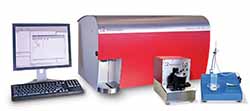 Analysis of raw and finished dairy products is reliable with analytical instrumentation by Advanced Instruments and its subsidiary, Delta Instruments. The LactoScope™ C3+/C4+ and LactoScope™ FTIR Advanced spectrophotometers determine levels of fat, protein, lactose, and total solids in milk and salt content in cheese. In addition, the ultra-sensitive Fluorophos® provides pasteurization tests on dairy products. Advanced Instruments, www.aicompanies.com, Booth 3342
Analysis of raw and finished dairy products is reliable with analytical instrumentation by Advanced Instruments and its subsidiary, Delta Instruments. The LactoScope™ C3+/C4+ and LactoScope™ FTIR Advanced spectrophotometers determine levels of fat, protein, lactose, and total solids in milk and salt content in cheese. In addition, the ultra-sensitive Fluorophos® provides pasteurization tests on dairy products. Advanced Instruments, www.aicompanies.com, Booth 3342
Protection against pathogens requires quality sanitizer solutions. The HACCP Defender™ Automatic Boot Sanitizing Station adds an additional layer of protection against pathogens by reducing cross-contamination before employees enter critical control areas. The sanitizing station is but one of the sanitation solutions offered by Best Sanitizers, Inc. The company also provides ready-to-use, no-rinse, food-safe sanitizing wipes; hand sanitizers; and special soaps. Best Sanitizers, www.bestsanitizers.com, Booth 2148
A rapid test to check for the presence of polar compounds in frying oil will soon be available in the United States. OleoTest monitors the changes oils undergo as they are exposed to heat, light, moisture, and oxygen, which can create polar compounds such as monoglycerides and diglycerides. Polar compounds in oils affect the composition of oils and the products fried in them, compromising the taste and quality of deep-fried foods. Emport LLC, www.emportllc.com, Booth 608
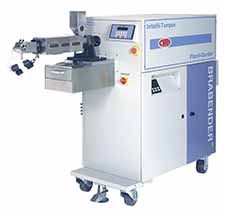 High-quality instruments for testing physical properties and quality of materials are C.W. Brabender’s specialty. The company creates instruments for testing materials used by the milling, baking, and starch industries and is an industry leader in food extrusion. The Intelli-Torque Plasti-Corder® makes use of CAN Field Bus Technology and can accommodate any C.W. Brabender mixer or extruder attachment. C.W. Brabender, www.cwbrabender.com, Booth 2718
High-quality instruments for testing physical properties and quality of materials are C.W. Brabender’s specialty. The company creates instruments for testing materials used by the milling, baking, and starch industries and is an industry leader in food extrusion. The Intelli-Torque Plasti-Corder® makes use of CAN Field Bus Technology and can accommodate any C.W. Brabender mixer or extruder attachment. C.W. Brabender, www.cwbrabender.com, Booth 2718
A natural, biodegradable wash made with citrus extract increases quality. CitroBio extends shelf life and has been proven effective against E. coli, Salmonella, Listeria, and other pathogens. It has no flavor and does not affect the color of foods. CitroBio is GRAS and can be used on seafood, meat, poultry, cheese, and produce. CitroBio, Inc., www.citrobio.com, Booth 301
Software for sensory science and consumer interaction provide innovative services. Compusense Five, a sensory software, allows customization of tests, facilitates panel training, and provides easy test replication. Compusense at-Hand, a web-based software platform, provides to clients the ability to evaluate concepts or products from virtually anywhere. Compusense, www.compusense.com, Booth 5141
--- PAGE BREAK ---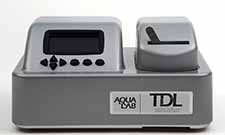 A tunable diode laser updates instrumentation that measures water activity. The AquaLab 4TE is a research-grade meter that measures water activity with high accuracy in less than five minutes. The meter’s new features focus on the precise wavelength of water vapor and is said to be more reliable than other water activity sensors. Decagon Devices, Inc., www.aqualab.com, Booth 1235
A tunable diode laser updates instrumentation that measures water activity. The AquaLab 4TE is a research-grade meter that measures water activity with high accuracy in less than five minutes. The meter’s new features focus on the precise wavelength of water vapor and is said to be more reliable than other water activity sensors. Decagon Devices, Inc., www.aqualab.com, Booth 1235
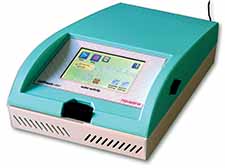 A touchscreen water activity meter makes measurements easy. The LabTouch-aw by Novasina/Neutec Group offers fast menu access via a touchscreen and a semi-temperature-stabilized measurement chamber. These functionalities allow for consistent, reproducible results along with a userfriendly ergonomic design. Data storage on SD cards facilitates the convenient transfer of test results to a computer or printer. Neutec Group Inc., www.neutecgroup.com, Booth 1211
A touchscreen water activity meter makes measurements easy. The LabTouch-aw by Novasina/Neutec Group offers fast menu access via a touchscreen and a semi-temperature-stabilized measurement chamber. These functionalities allow for consistent, reproducible results along with a userfriendly ergonomic design. Data storage on SD cards facilitates the convenient transfer of test results to a computer or printer. Neutec Group Inc., www.neutecgroup.com, Booth 1211
Computer software for nutrient analysis facilitates automated label creation. Genesis R&D automates nutrient analysis and the creation of a variety of labels. Food Processor evaluates client dietary needs and analyzes nutrient intake levels. And Food Prodigy documents client intakes and activities electronically. ESHA Research, www. esha.com, Booth 3241
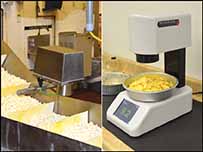 Near infrared and infrared measurement devices provide accurate results. Process Sensors Corp. offers a near infrared moisture/oil transmitter that has a dual core microprocessor for increased stability, a standard 5.7-inch touchscreen, and a built-in cooling panel and air-purge assembly. The company also has a smaller and lighter bench-top near infrared moisture transmitter, the MCT466 QuikCheck, that is easier to use and elicits instant readings. Process Sensors Corp., www.processsensors.com, Booth 5451
Near infrared and infrared measurement devices provide accurate results. Process Sensors Corp. offers a near infrared moisture/oil transmitter that has a dual core microprocessor for increased stability, a standard 5.7-inch touchscreen, and a built-in cooling panel and air-purge assembly. The company also has a smaller and lighter bench-top near infrared moisture transmitter, the MCT466 QuikCheck, that is easier to use and elicits instant readings. Process Sensors Corp., www.processsensors.com, Booth 5451
Molecular diagnostic testing is now possible in any environment. F Cubed LLC offers molecular AC dielectrophoretic technology that can identify various pathogens in a raw food sample in less than two hours. The portability of the company’s products means that water, soil, fruits, vegetables, and grains can be tested at the source: farms, warehouses, supermarket storage areas, etc. F Cubed LLC, www.fcubed.biz, Booth 3559
 A mass spectrometer maintains spectrum quality, sensitivity, and accuracy at high speeds. The LCMS-8050 triple quadrupole mass spectrometer can obtain qualitative and quantitative information in a single analysis at unparalleled measurement speeds. The device can also acquire 555 multiple-reaction-monitoring transitions per second while maintaining precision. Shimadzu Scientific Instruments Inc., www.ssi.shimadzu.com, Booth 1409
A mass spectrometer maintains spectrum quality, sensitivity, and accuracy at high speeds. The LCMS-8050 triple quadrupole mass spectrometer can obtain qualitative and quantitative information in a single analysis at unparalleled measurement speeds. The device can also acquire 555 multiple-reaction-monitoring transitions per second while maintaining precision. Shimadzu Scientific Instruments Inc., www.ssi.shimadzu.com, Booth 1409
Controlling the color and appearance of food, beverage, and packaging products has become more efficient. Konica Minolta Sensing Americas, Inc., provides instruments and software technology that measure color, facilitating the achievement of color quality standards with less waste, time, and effort. The company offers colorimeters, spectrophotometers, color analysis software, and general laboratory equipment. Konica Minolta Sensing Americas, Inc., http://sensing.konicaminolta.us, Booth 3017
--- PAGE BREAK ---
Chemistry analysis, food safety, physical testing, and microbiology are all under one roof. Medallion Laboratories combines state-of-the-art equipment, the expertise of more than 100 scientists, and ISO/IES 17025 accreditation to provide reliable analytical results. The company also offers nutrient analysis, package testing, and sensory evaluation. Medallion Laboratories, www.medallionlabs.com, Booth 1316
Dietary fiber analysis with high purity is possible with a new product. The K-INTDF integrated dietary fiber assay kit can test samples containing a mixed group of dietary fiber, including the prebiotic LMWDF, non-digestible oligosaccharides, and resistant starch. The kit is useful for ingredient companies and food manufacturers that incorporate dietary fiber into their products to increase fiber content. Megazyme, www.megazyme.com, Booth 5714
Sterile polyethylene bags make transporting samples convenient and simple with sterile polyethylene bags. Whirl-Pak® sterile sample bags are useful for transporting samples for quality assurance and microbiological testing as well as other applications. The sample bags feature patented puncture proof tabs that minimize punctures. Nasco, www.whirl-pak.com, Booth 316
Patented antimicrobial products extend the shelf life of fresh-cut produce. NatureSeal Inc. offers a patented line of products that maintain the fresh qualities of cut vegetables and fruits. The company’s First Step+10 is a sanitizing produce wash that kills pathogens and was developed with the U.S. Dept. of Agriculture. The wash can be used on whole and fresh-cut produce. NatureSeal Inc., www.natureseal.com, Booth 1119
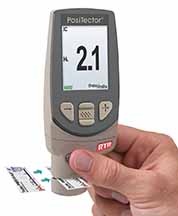 A hand-held refractometer now fits in a pocket. PAL is a series of digital hand-held refractometers that are compact enough to fit into the pockets of clothing. The food-industry refractometers come in various versions to measure citric acid, tartaric acid, lactic acid, honey, beer, wine, and salt. Paul N. Gardner Co., Inc., offers the PAL line of refractometers as well as other instruments for testing and ensuring quality control in the food industry. Paul N. Gardner Co., Inc., www.gardco.com, Booth 1901
A hand-held refractometer now fits in a pocket. PAL is a series of digital hand-held refractometers that are compact enough to fit into the pockets of clothing. The food-industry refractometers come in various versions to measure citric acid, tartaric acid, lactic acid, honey, beer, wine, and salt. Paul N. Gardner Co., Inc., offers the PAL line of refractometers as well as other instruments for testing and ensuring quality control in the food industry. Paul N. Gardner Co., Inc., www.gardco.com, Booth 1901
Quality food and feed testing is being provided by an industry leader. The chemists and microbiologists at NP Analytical Laboratories have pioneered techniques for analysis of vitamins, amino acids, carbohydrates, and preservatives. The company also provides comprehensive testing for nutrients, contaminants, pathogens, and quality assurance. NP Analytical Laboratories, www.npal.com, Booth 1412
Food safety, quality, and nutrition solutions can be customized to meet specific needs. Silliker offers practical solutions throughout the supply chain to help food companies ensure the safety and quality of their products. Silliker provides testing, auditing, consulting, training, and research that enables companies to protect their brands. Silliker, Inc., www.silliker.com, Booth 1721
Analytical studies of proteins and hydrolysates is available from one source. TNO Triskelion uses liquid chromatography-mass spectrometry along with protein purification protocols and enzymatic treatments to analyze proteins and hydrosylates. TNO Triskelion’s instrumentation provides profiling of hydrosylates, sequence analysis of peptides and proteins, and identification and localization of posttranslational modifications. TNO Triskelion, www.tnotriskelion.com, Booth 2325
Quality analytical services provide end solutions for food testing. Waters Corp. offers food testing analytics that include sample preparation, chromatography, mass spectrometry, and data management software. The company’s equipment and services are sensitive and versatile, meeting regulatory requirements for food safety, quality control, and profiling. Waters Corp., www.waters.com, Booth 4812
 Neil H. Mermelstein, a Fellow of IFT,
Neil H. Mermelstein, a Fellow of IFT,
is Editor Emeritus of Food Technology
[email protected]


